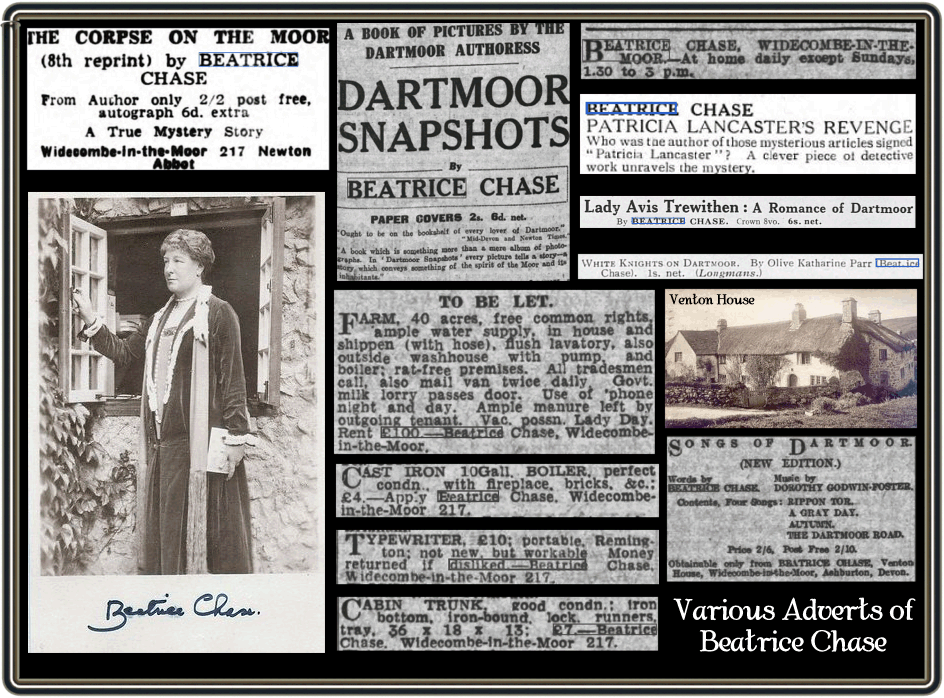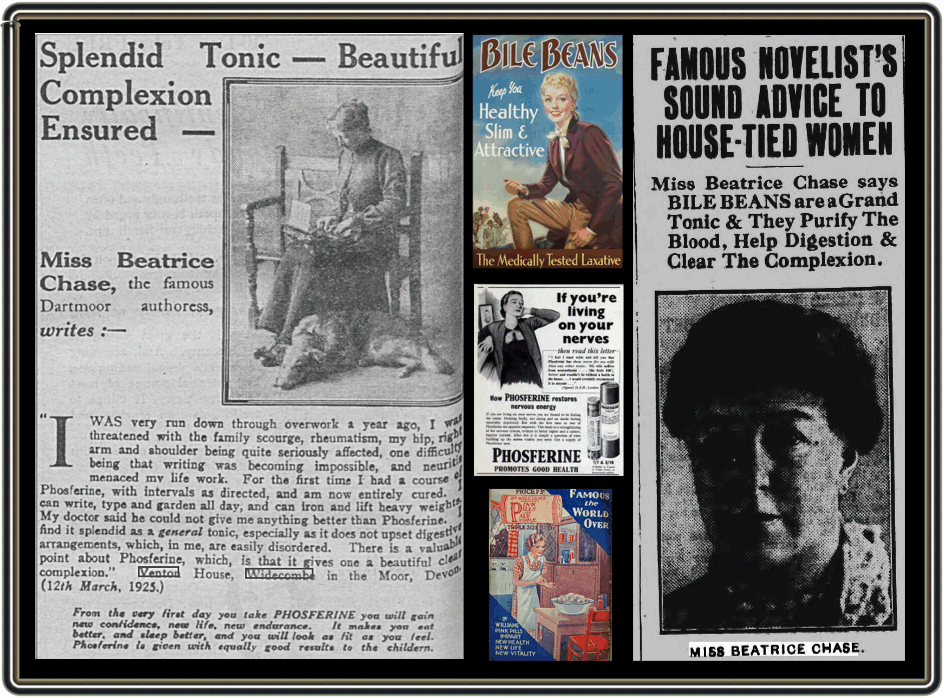
In this day and age we are all well conversant with famous sports stars, film celebrities, pop stars, authors, artists etc. endorsing merchandise, appearing on Social Media and in various newspapers and TV. The bigger the star the more money they can earn and in some cases the figures can turn into the tens of thousands of pounds, providing they behave themselves. But I beg the question, can you think of anyone with a Dartmoor connection who could earn a good living from such media platforms? Well, there was one person who managed to do this and what is more surprising is how long ago they did it.
Beatrice Chase (aka Olive Katherine Parr) was a celebrated authoress and Dartmoor notable who lived at Venton, near Widecombe-in-the-Moor from 1908 to 1955. Between 1903 and the early 1950s she published over 25 books. These publications consisted of novels, plays, poetry and her photographic works along with various contributions to other publications, all sold to a worldwide audience. She clearly had a good eye for business and was well aware of her celebrity status, so much so that in later years she referred to herself as ‘My Lady of the Moor’. Over the years Beatrice Chase regularly wrote many letters to the local newspapers on local and national topics, often giving her thoughts on such matters which at times were quite controversial. Regardless of their content these letters it ensured that she was regularly in the public’s eye which in turn enhanced her fame and reputation. Today this would be achieved by using the various forms of social media such as blogs etc. Speak to any ‘search engine optimisation expert and they will tell you that the first rule of recognition is a constant stream of posts, comments and features. So in a way one could say that Beatrice Chase was well aware of this theory albeit limited to the media outlets of the time. It then followed on that through her books and her standing within the public’s gaze that many other opportunities arose.
In the early 1920s she was approached by various American screen producers and one of them, Maurice Revues, was given the option on three of her books; ‘The Red-Handed Saint’, ‘Back Slum Idols’ and ‘The Little Cardinal’. In addition there were negotiations in place with British film producers for short films based on her ‘The Heart of the Moor’ and ‘The Dartmoor Window’ series. In 1924 the authoress took the brave step to publish her own books as in her opinion the publishers took too great a profit margin on her work. She stated that: “I object to the infamous profits made by the book sellers in comparison to what the author receives. The author is paid from 10 to 15 percent in royalties, whereas the book seller obtains 35 to 40 percent.” The benefit of using publishers is that they have a large network of outlets in which to source any books. Without these contacts it means that one had to find their own outlets which initially was a time-consuming task. However, in her case such was her fame that many ‘hundreds’ of people visited her at Venton and she always took the opportunity to sell them autographed copies (at an extra cots) of her books. She noted at the time; “During the past two summers I have been selling copies of my ‘White Knight’s Crusade’ to hundreds of people who visit my home here, and find that they like buying books in such romantic surroundings. Then everybody likes to obtain an autographed work, and it is little trouble to autograph the book at my home.” Not only did the woman sell the books to her visitors she then kept their contact details in two huge ledgers, the idea being to use them as a kind of customer list for future sales. In some of her writings Beatrice Chase portrayed Dartmoor and especially her home at Venton as a vision of heaven. This had the effect of encouraging visitors to experience what they had read, in a way she was acting as a local ‘tourist board’ for her home, thus ensuring a greater footfall for her book sales.
In order to take advantage of her reputation she also began endorsing some dubious ‘herbal’ remedies which appeared as advertisements in various newspapers. In 1925 she began endorsing a product called Phosferine. In the advert of the time she declared; “I was very run down through work a year ago, I was threatened with the family scourge, rheumatism, my hip, right arm and shoulder being quite seriously affected, one difficulty was that writing was becoming impossible, and neuritis menaced my life’s work. For the first time I had a course of Phosferine, with intervals as directed, and am now entirely cured. I can write, type and garden all day, and can iron and lift heavy weights. My doctor said he could not give me anything better than Phosferine. I find it splendid as a general tonic, especially as it does not upset digestive arrangements, which in me, are easily disordered. There is a valuable point about Phosferine, which, is that it gives one a beautiful clear complexion.” – Venton House, Widecombe in the Moor, Devon. 12th March 1925. Analysis of Phosferine at the time found that it contained; quinine sulphate, diluted sulphuric acid, diluted phosphoric acid, alcohol and water. It was estimated that the cost of producing 1 fluid ounce of Phosferine was ½d which was the sold for 2 shillings and nine pence which gave a profit of 6,500 %.
1925 also saw Miss Chase venture into the world of music in collaboration with composer Dorothy Godwin-Foster, the lyrics were taken from Chase’s book – ‘Gorse Blossoms from Dartmoor’. In keeping with her new publishing venture the press advert stated that copies of this could be obtained from Venton. In 1929 the outbuildings at Venton were used as a location in Anthony Asquith’s film – ‘A Cottage on Dartmoor’ and no doubt Beatrice’s knowledge of the moor pointed him towards other moorland locations. In 1931 adverts were appearing in the personal columns of the press stating that; “BEATRICE CHASE, Widecombe-in-the-Moor, at home daily, except Sundays, 1-30 to 3.00 pm.” , which basically advertised the opening hours for visits and the purchases of her books. In the same year Beatrice Chase was endorsing the virtues of ‘Bile Beans’ with an advert stating; “Doctors, nurses, public officials and all classes acknowledge the exceptional qualities of Bile Beans, the famous vegetable pills. The well-known authoress, Miss Beatrice Chase, writing from Venton House, Widecombe-in-the-Moor, Devonshire, Says; “All housewives and sedentary workers should take Bile Beans, not occasionally but regularly. Toiling long hours in the kitchen, or at ones desk, uses up tremendous nervous force which is at expense of other parts of the system and often leads to digestive trouble.
Bile Beans are in a class quite by themselves. They are worth more than their weight in gold. I would not be without them. They make the functions of the body work gently and regularly without any of the ‘shocks’ which salts and minerals give.”
Bile Beans, a purely vegetable pill, however, are unmistakably soothing and tonic. Their purifying action on the blood improves both the skin and complexion. I am heartily grateful to Bile Beans.” Sold at 1/3 or 3/- by all chemists. Every box is sealed with the Government stamp.
Bile Beans were supposed to have come from an original Aborigine vegetable source which was known only to them. According to a 1903 report published in the British Medical Journal the chief ingredients of Bile Beans were cascara, rhubarb, liquorice and menthol formulated as a gelatine-coated pill, By the 1940s, the ingredients included various purgatives, cholagogues, and carmininatives including aloe, may apple, cascara, scammony, jalap, colocynth, leptandrin, soap, cardamom, capsicum, ginger, peppermint oil and gentian, mixed with liquorice, powdered gum, glucose, coated with black charcoal to form ovid pills.
The next step in her career occurred in 1932 when she was invited by the B.B.C. to broadcast a chapter of her ‘Heart of Dartmoor’ book on air. This year additionally saw the woman extolling the virtues of her latest enterprise with adverts stating: “I can imagine no more helpful, lucrative and enthralling pursuit than photography. Beatrice Chase, the novelist. Some of her photographs were sold to Raphael Tuck the postcard printer. The following year the authoress was to make her first screen appearance when she agreed to be one of the subject in a series about famous authors. Could it be that with an ever eye open for promotional opportunities she had arranged for the film to be shot at Venton with one of the scenes showing her autographing her books?
It will be hard to ascertain how much money Beatrice Chase was earning through her various ventures but what is known that she was very supportive financially of both local and national causes. On one occasion she sold some of her jewellery to pay for a printers bill in order to support her ‘Save Dartmoor’ campaign. This was an effort to stop the War Office proposals of using Dartmoor as a training ground. During the late 1930s the authoress became a recluse and some say she became bitter and spiteful, either way the sales of her books dramatically decline and she resorted to selling many of her possessions. Adverts appeared in the local press offering her typewriter (she also gave this a name – Remington Aquinate), a boiler, an old tin chest, an invalid stair chair and other objects for sale (see above). In 1954 she was removed from Venton by the local health authority because she was deemed to be a person in need of care but was allowed home again after three weeks. The following year she was taken into Newton Abbot Infirmary to recover from a burst varicose vein sustained whilst walking at Dartmeet. It was here she died from cancer on what would have been two days before her 81st birthday – the 3rd of July 1955.
 Legendary Dartmoor The many aspects past and present of Dartmoor
Legendary Dartmoor The many aspects past and present of Dartmoor



Tim,
Really enjoyed both your recent pieces on Beatrice Chase, and whilst you are in “chase” mode I wondered if you coulddo/ have done anything on her famous “Mr Bluejackets” her ex Royal Naval man servants. I am aware of Gilbert Halse Palmer whom I believe may have been the first one, but he had left her service by 1916, and Bob Hitchcock did not commence until the spring of 1922 so a gap there. I have no information regarding any others and wondered if you Had?
Regards
David Ashman